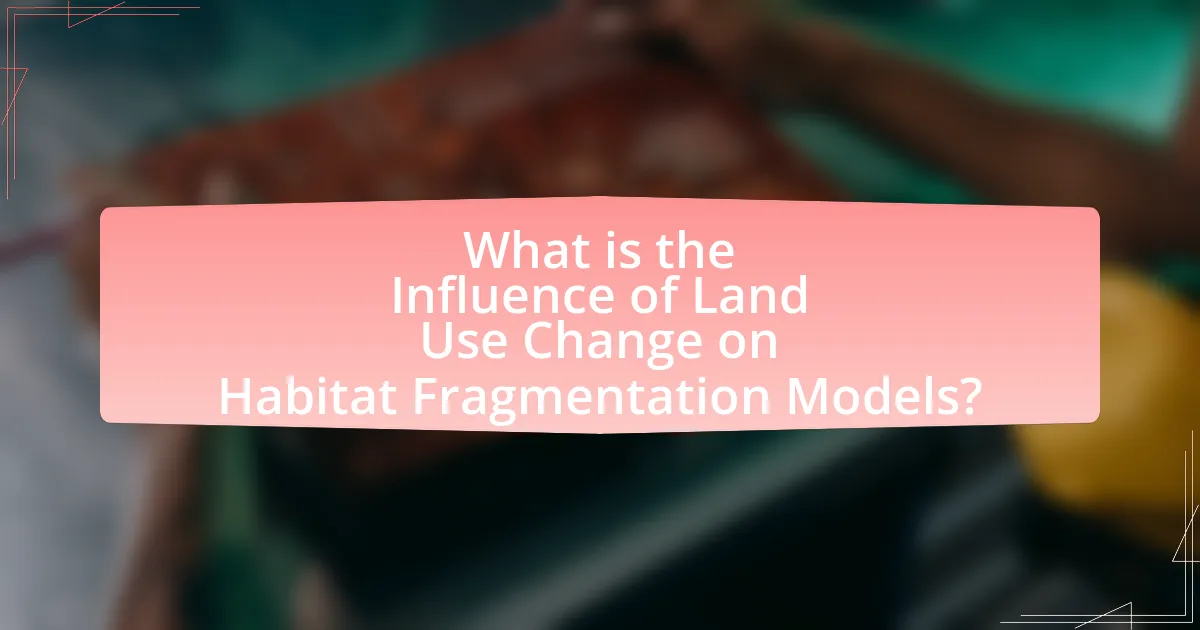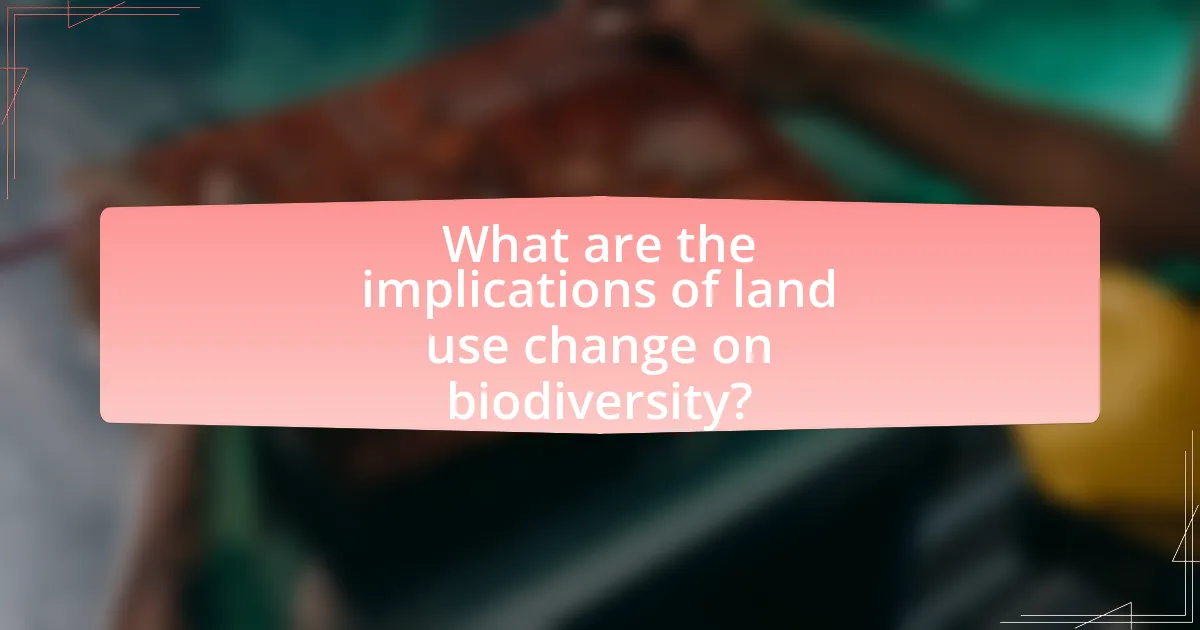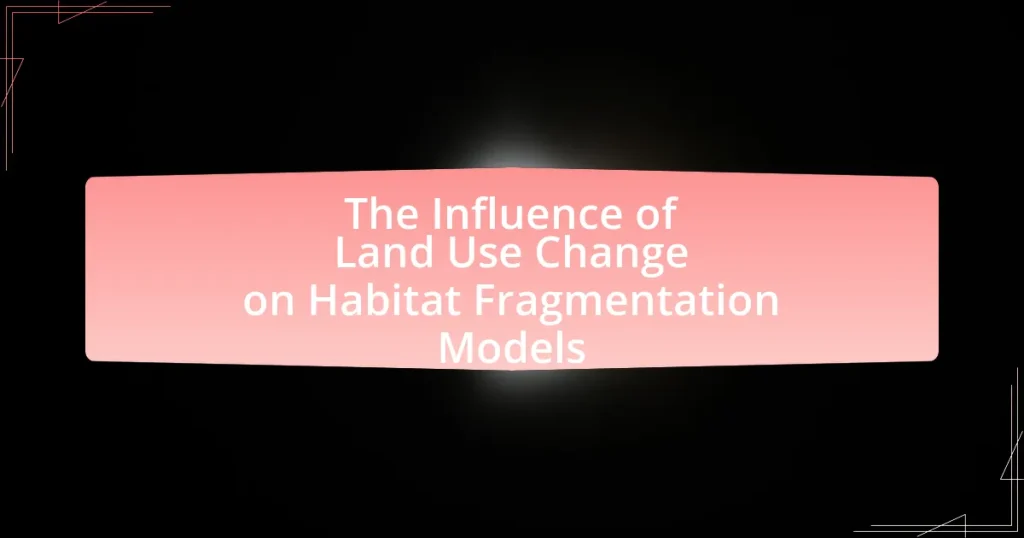The article examines the significant influence of land use change on habitat fragmentation models, highlighting how alterations in land use, such as urbanization and agricultural expansion, disrupt habitat connectivity and spatial configuration. It discusses the primary drivers of land use change, including economic development and environmental policies, and their effects on biodiversity and ecosystem health. The article emphasizes the importance of understanding habitat fragmentation models for conservation efforts, detailing key components, necessary data, and best practices for effective modeling. Additionally, it explores regional variations in land use change and their implications for habitat fragmentation, underscoring the need for tailored strategies to mitigate negative impacts on wildlife and ecosystems.

What is the Influence of Land Use Change on Habitat Fragmentation Models?
Land use change significantly influences habitat fragmentation models by altering the spatial configuration and connectivity of habitats. This alteration can lead to increased isolation of wildlife populations, reduced genetic diversity, and disrupted ecological processes. For instance, urbanization and agricultural expansion often result in the conversion of natural landscapes into fragmented patches, which can be quantitatively assessed using metrics such as patch size, edge density, and connectivity indices. Studies have shown that habitat fragmentation due to land use change can decrease species richness and abundance, as evidenced by research conducted by Fahrig (2003) in “Effect of Habitat Fragmentation on Biodiversity.” This research highlights that as land use changes, the resulting fragmentation can have profound effects on biodiversity and ecosystem functionality, validating the critical role of land use change in shaping habitat fragmentation models.
How does land use change impact habitat fragmentation?
Land use change significantly impacts habitat fragmentation by altering the spatial configuration and connectivity of ecosystems. When land is converted for agriculture, urban development, or infrastructure, it often results in the division of habitats into smaller, isolated patches. Research indicates that habitat fragmentation can lead to decreased biodiversity, as species struggle to find food, mates, and migrate between patches. For instance, a study published in “Ecological Applications” by Fahrig (2003) demonstrates that fragmented habitats can reduce species richness by up to 75% compared to continuous habitats. This evidence underscores the critical relationship between land use change and the fragmentation of habitats, highlighting the need for sustainable land management practices to preserve ecological integrity.
What are the primary drivers of land use change?
The primary drivers of land use change include urbanization, agricultural expansion, deforestation, and infrastructure development. Urbanization leads to the conversion of natural landscapes into urban areas, significantly altering land use patterns. Agricultural expansion often results in the clearing of forests and grasslands to create farmland, which can lead to habitat loss. Deforestation, driven by logging and land conversion for agriculture, directly impacts biodiversity and ecosystem services. Infrastructure development, such as roads and buildings, further fragments habitats and alters land use dynamics. These drivers are supported by data indicating that urban areas have increased by over 50% globally since 1990, while agricultural land has expanded by approximately 12% in the same period, highlighting the significant impact of these factors on land use change.
How does habitat fragmentation occur as a result of land use change?
Habitat fragmentation occurs as a result of land use change when large, continuous habitats are divided into smaller, isolated patches due to activities such as agriculture, urban development, and infrastructure expansion. This division disrupts ecosystems, leading to reduced biodiversity and altered species interactions. For instance, a study by Fahrig (2003) in “Effects of Habitat Fragmentation on Biodiversity” highlights that fragmentation can decrease species richness and abundance by limiting access to resources and increasing edge effects. Additionally, the conversion of forests into agricultural land has been shown to reduce habitat connectivity, further exacerbating the impacts of fragmentation on wildlife populations.
Why is understanding habitat fragmentation models important?
Understanding habitat fragmentation models is important because they provide insights into how land use changes affect biodiversity and ecosystem health. These models help predict the consequences of habitat loss and fragmentation on species survival, migration patterns, and genetic diversity. For instance, studies have shown that fragmented habitats can lead to a decline in species populations, as evidenced by research indicating that isolated populations are more vulnerable to extinction due to reduced genetic diversity and increased inbreeding. By utilizing habitat fragmentation models, conservationists can develop effective strategies to mitigate the negative impacts of land use changes, ensuring the preservation of ecosystems and the species that inhabit them.
What role do habitat fragmentation models play in conservation efforts?
Habitat fragmentation models play a crucial role in conservation efforts by predicting the impacts of land use changes on wildlife populations and ecosystems. These models help identify critical habitats and corridors necessary for species movement, thereby informing land management and conservation strategies. For instance, studies have shown that habitat fragmentation can lead to decreased biodiversity and increased extinction rates, emphasizing the need for effective conservation planning. By utilizing these models, conservationists can prioritize areas for protection and restoration, ensuring that ecosystems remain resilient in the face of ongoing land use changes.
How do these models help predict species distribution?
Models help predict species distribution by analyzing environmental variables and species occurrence data to identify suitable habitats. These models utilize algorithms that correlate species presence with factors such as climate, topography, and land use changes, allowing researchers to forecast how species may respond to habitat fragmentation. For instance, studies have shown that species distribution models can accurately predict shifts in species ranges due to land use changes, as evidenced by research published in “Ecological Applications,” which demonstrated that habitat loss significantly impacts species viability and distribution patterns.
What are the key components of habitat fragmentation models?
The key components of habitat fragmentation models include patch size, patch connectivity, edge effects, and species response. Patch size refers to the area of habitat fragments, which influences species survival and biodiversity; larger patches typically support more species. Patch connectivity describes how well different habitat patches are linked, affecting species movement and gene flow; higher connectivity enhances population viability. Edge effects involve changes in environmental conditions at the boundaries of habitat fragments, which can impact species behavior and ecosystem processes. Species response encompasses how different species react to fragmentation, with some being more resilient than others, thus influencing overall ecosystem health. These components are essential for understanding the ecological consequences of land use changes on habitat fragmentation.
What data is required to develop effective habitat fragmentation models?
Effective habitat fragmentation models require spatial data on land use, species distribution, and ecological connectivity. Spatial data on land use provides insights into how human activities alter habitats, while species distribution data identifies the presence and abundance of species across different landscapes. Ecological connectivity data assesses how well different habitat patches are linked, which is crucial for understanding movement patterns and gene flow among populations. These data types are essential for accurately modeling the impacts of land use change on habitat fragmentation, as they allow researchers to quantify changes in habitat availability and quality, ultimately influencing biodiversity outcomes.
How do different modeling approaches compare in their effectiveness?
Different modeling approaches exhibit varying effectiveness in predicting habitat fragmentation due to land use change. For instance, spatially explicit models, such as agent-based models, provide detailed insights into individual behaviors and interactions, leading to more accurate predictions of fragmentation patterns. In contrast, statistical models, while simpler and faster to implement, often rely on aggregate data and may overlook critical spatial dynamics, resulting in less precise outcomes. Research by Turner et al. (2015) in “Ecological Modelling” demonstrates that agent-based models can capture complex interactions better than traditional statistical methods, leading to improved predictions of habitat loss and fragmentation. Thus, the choice of modeling approach significantly influences the accuracy and reliability of habitat fragmentation assessments.

How do land use changes vary across different regions?
Land use changes vary significantly across different regions due to factors such as economic development, population density, and environmental policies. For instance, urban areas often experience rapid land conversion from agricultural or natural landscapes to residential and commercial developments, as seen in cities like Los Angeles and Beijing, where urban sprawl has led to substantial habitat loss. In contrast, rural regions may see land use changes driven by agricultural expansion or deforestation, particularly in areas like the Amazon rainforest, where agricultural practices have led to extensive habitat fragmentation. Additionally, regions with strong conservation policies, such as national parks in the United States, may experience less land use change, preserving habitats compared to regions lacking such protections. These variations highlight the complex interplay of socio-economic and environmental factors influencing land use across different geographical contexts.
What factors influence regional differences in land use change?
Regional differences in land use change are influenced by factors such as economic development, population density, government policies, and environmental conditions. Economic development drives urbanization and agricultural expansion, while higher population density often leads to increased land conversion for housing and infrastructure. Government policies, including zoning laws and land use regulations, can either promote or restrict land development. Environmental conditions, such as climate, soil quality, and topography, also dictate the suitability of land for various uses, impacting how land is utilized across different regions. For instance, regions with fertile soil may experience more agricultural land use, while urban areas may prioritize residential and commercial development.
How do socio-economic factors affect land use decisions?
Socio-economic factors significantly influence land use decisions by determining the priorities and capabilities of communities and governments. For instance, higher income levels often lead to increased demand for residential and commercial development, while lower income areas may prioritize agricultural or industrial land use due to economic necessity. Additionally, policies shaped by socio-economic conditions, such as zoning laws and land taxes, directly impact how land is allocated and utilized. Research indicates that regions with robust economic growth tend to experience more rapid urbanization, which can lead to habitat fragmentation, as natural areas are converted into developed land. This relationship underscores the importance of socio-economic context in shaping land use patterns and their ecological consequences.
What environmental factors contribute to variations in land use change?
Environmental factors that contribute to variations in land use change include climate, topography, soil type, and water availability. Climate influences agricultural practices and urban development, as regions with favorable climates tend to experience more intensive land use. Topography affects accessibility and suitability for different land uses, with mountainous areas often being less developed than flat plains. Soil type determines agricultural productivity, influencing land conversion for farming. Water availability is crucial for both agriculture and urban areas, as regions with abundant water resources are more likely to support intensive land use. Studies have shown that these factors interact with socio-economic conditions, further driving land use changes. For instance, a study published in “Global Environmental Change” by Seto et al. (2012) highlights how climate and socio-economic factors together shape land use patterns globally.
How do these regional differences affect habitat fragmentation models?
Regional differences significantly affect habitat fragmentation models by influencing the parameters and assumptions used in these models. Variations in land use, climate, and ecological characteristics across regions lead to different fragmentation patterns, which must be accurately represented to predict ecological outcomes. For instance, urban areas may exhibit higher levels of fragmentation due to infrastructure development, while agricultural regions may show fragmentation driven by crop patterns. Studies, such as those by Fahrig (2003), demonstrate that habitat loss and fragmentation can vary widely based on regional land use practices, underscoring the necessity for models to incorporate local data to enhance predictive accuracy.
What adjustments are necessary for models to account for regional variations?
Models must incorporate local ecological data, socio-economic factors, and land use patterns to account for regional variations effectively. This adjustment ensures that the models reflect the unique characteristics of different regions, such as species diversity, climate conditions, and human impact on land use. For instance, studies have shown that habitat fragmentation responses can vary significantly across regions due to differing land management practices and environmental conditions, necessitating tailored modeling approaches to accurately predict outcomes.
How can local data improve the accuracy of habitat fragmentation models?
Local data enhances the accuracy of habitat fragmentation models by providing specific, context-rich information about the landscape and species interactions. This localized information allows for more precise modeling of habitat connectivity, species movement patterns, and the impacts of land use changes. For instance, studies have shown that incorporating local vegetation types and land use patterns can significantly improve model predictions, as these factors directly influence habitat quality and availability. Research by Fahrig (2003) in “Effect of Habitat Fragmentation on Biodiversity” demonstrates that models utilizing local data can better reflect the ecological realities faced by species in fragmented landscapes, leading to more effective conservation strategies.

What are the implications of land use change on biodiversity?
Land use change significantly impacts biodiversity by altering habitats, leading to species loss and ecosystem degradation. When natural landscapes are converted for agriculture, urban development, or infrastructure, the resulting habitat fragmentation disrupts species’ migration patterns and reduces genetic diversity. For instance, a study published in “Global Change Biology” by Fahrig (2017) indicates that habitat loss and fragmentation can lead to a decline in species richness, with a 10% increase in habitat loss correlating to a 20% decrease in species diversity. Additionally, land use change can introduce invasive species, further threatening native biodiversity. These changes create a cascade of ecological consequences, ultimately diminishing ecosystem services that are vital for human well-being.
How does habitat fragmentation influence species diversity?
Habitat fragmentation negatively influences species diversity by isolating populations and reducing genetic variability. When habitats are divided into smaller, disconnected patches, species face challenges such as limited resources, increased competition, and higher vulnerability to extinction. Research indicates that fragmented landscapes can lead to a decline in species richness; for instance, a study published in “Ecology Letters” by Fahrig (2003) found that habitat fragmentation can reduce species diversity by up to 75% in certain ecosystems. This reduction occurs because smaller habitat patches often cannot support viable populations, leading to local extinctions and decreased overall biodiversity.
What are the effects of fragmentation on species interactions?
Fragmentation negatively impacts species interactions by isolating populations, which can lead to reduced genetic diversity and increased vulnerability to extinction. Isolated habitats limit the movement of species, disrupting predator-prey dynamics and mutualistic relationships, such as those between pollinators and plants. Research indicates that fragmented landscapes can decrease species richness and abundance, as seen in studies like those by Fahrig (2003), which demonstrate that habitat loss and fragmentation significantly affect biodiversity and ecological processes.
How does habitat loss impact endangered species?
Habitat loss critically impacts endangered species by reducing their living space, food sources, and breeding grounds, leading to population declines. For instance, the International Union for Conservation of Nature (IUCN) reports that habitat destruction is a primary threat to over 80% of species listed as endangered. As habitats are fragmented or destroyed, species become isolated, which hinders genetic diversity and increases vulnerability to extinction. Furthermore, specific studies, such as those published in “Conservation Biology,” indicate that habitat loss can lead to a 50% reduction in population sizes for many endangered species within just a few generations.
What strategies can mitigate the effects of land use change on habitat fragmentation?
Strategies to mitigate the effects of land use change on habitat fragmentation include establishing wildlife corridors, implementing land-use planning regulations, and restoring degraded habitats. Wildlife corridors facilitate animal movement between fragmented habitats, thereby maintaining genetic diversity and ecosystem functionality. Land-use planning regulations can limit urban sprawl and promote sustainable development, which helps preserve contiguous habitats. Restoration of degraded habitats can enhance connectivity and improve ecosystem resilience, as evidenced by studies showing that restored areas can support diverse species and reduce fragmentation impacts.
What role do protected areas play in preserving habitats?
Protected areas play a crucial role in preserving habitats by providing a designated space where ecosystems can thrive without the pressures of human development and exploitation. These areas help maintain biodiversity by protecting various species and their natural environments, which is essential for ecological balance. For instance, according to the International Union for Conservation of Nature, protected areas cover approximately 15% of the Earth’s land surface and are vital for conserving over 80% of the world’s terrestrial biodiversity. This preservation is critical in mitigating habitat fragmentation caused by land use changes, as it allows for the maintenance of ecological corridors and the resilience of ecosystems against external threats.
How can land use planning incorporate habitat connectivity?
Land use planning can incorporate habitat connectivity by integrating ecological networks into development frameworks. This approach involves identifying critical habitats and corridors that facilitate wildlife movement, thereby reducing fragmentation. For instance, the implementation of green infrastructure, such as wildlife corridors and greenways, has been shown to enhance connectivity between isolated habitats, promoting biodiversity. Research indicates that areas with well-planned connectivity measures experience higher species diversity and resilience, as evidenced by studies conducted in fragmented landscapes where connectivity improvements led to increased animal movement and genetic exchange.
What best practices should be followed in habitat fragmentation modeling?
Best practices in habitat fragmentation modeling include using high-resolution spatial data, incorporating ecological processes, and validating models with empirical data. High-resolution spatial data enhances the accuracy of habitat representation, allowing for better predictions of species movement and population dynamics. Incorporating ecological processes, such as dispersal and species interactions, ensures that models reflect real-world dynamics, which is crucial for understanding the effects of land use change. Validating models with empirical data, such as field studies or remote sensing observations, confirms the reliability of model predictions and helps refine future modeling efforts. These practices collectively improve the robustness and applicability of habitat fragmentation models in assessing the impacts of land use change.
How can researchers ensure data quality in habitat fragmentation studies?
Researchers can ensure data quality in habitat fragmentation studies by implementing standardized data collection protocols and utilizing advanced remote sensing technologies. Standardized protocols minimize variability and enhance reproducibility, while remote sensing provides accurate, high-resolution data on land use changes and habitat conditions. For instance, studies utilizing satellite imagery have shown a significant correlation between land use patterns and habitat fragmentation metrics, demonstrating the effectiveness of these methods in capturing reliable data.
What collaborative approaches can enhance model effectiveness?
Collaborative approaches that can enhance model effectiveness include interdisciplinary teamwork, stakeholder engagement, and data sharing. Interdisciplinary teamwork brings together experts from various fields, such as ecology, urban planning, and data science, to create comprehensive models that account for multiple factors influencing habitat fragmentation. Stakeholder engagement involves local communities, policymakers, and conservationists in the modeling process, ensuring that the models reflect real-world conditions and priorities. Data sharing among researchers and institutions facilitates access to diverse datasets, improving the accuracy and robustness of models. For instance, the integration of remote sensing data with local ecological knowledge has been shown to significantly improve habitat fragmentation assessments, as evidenced by studies like those conducted by Turner et al. (2015) in “Ecological Applications.”


